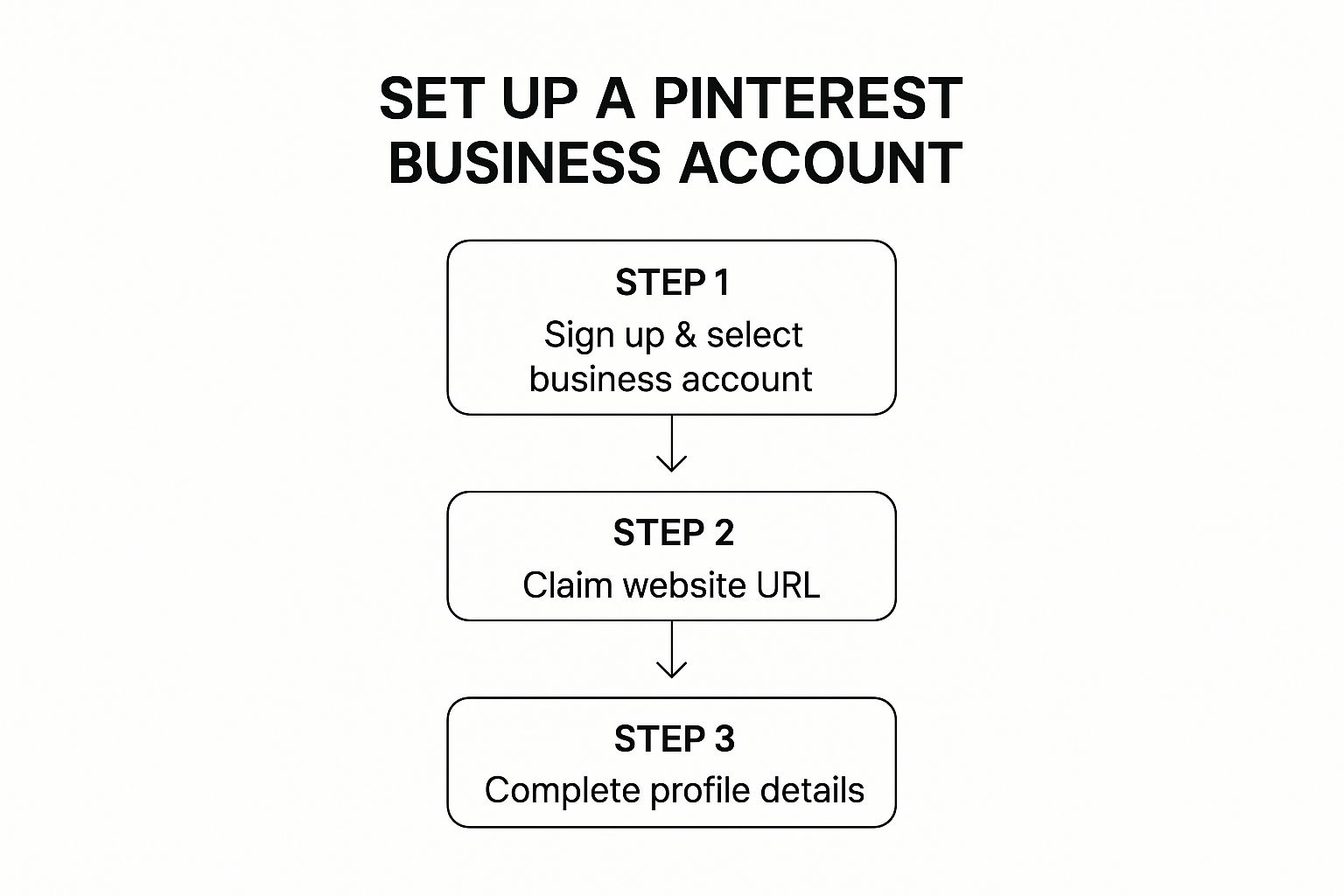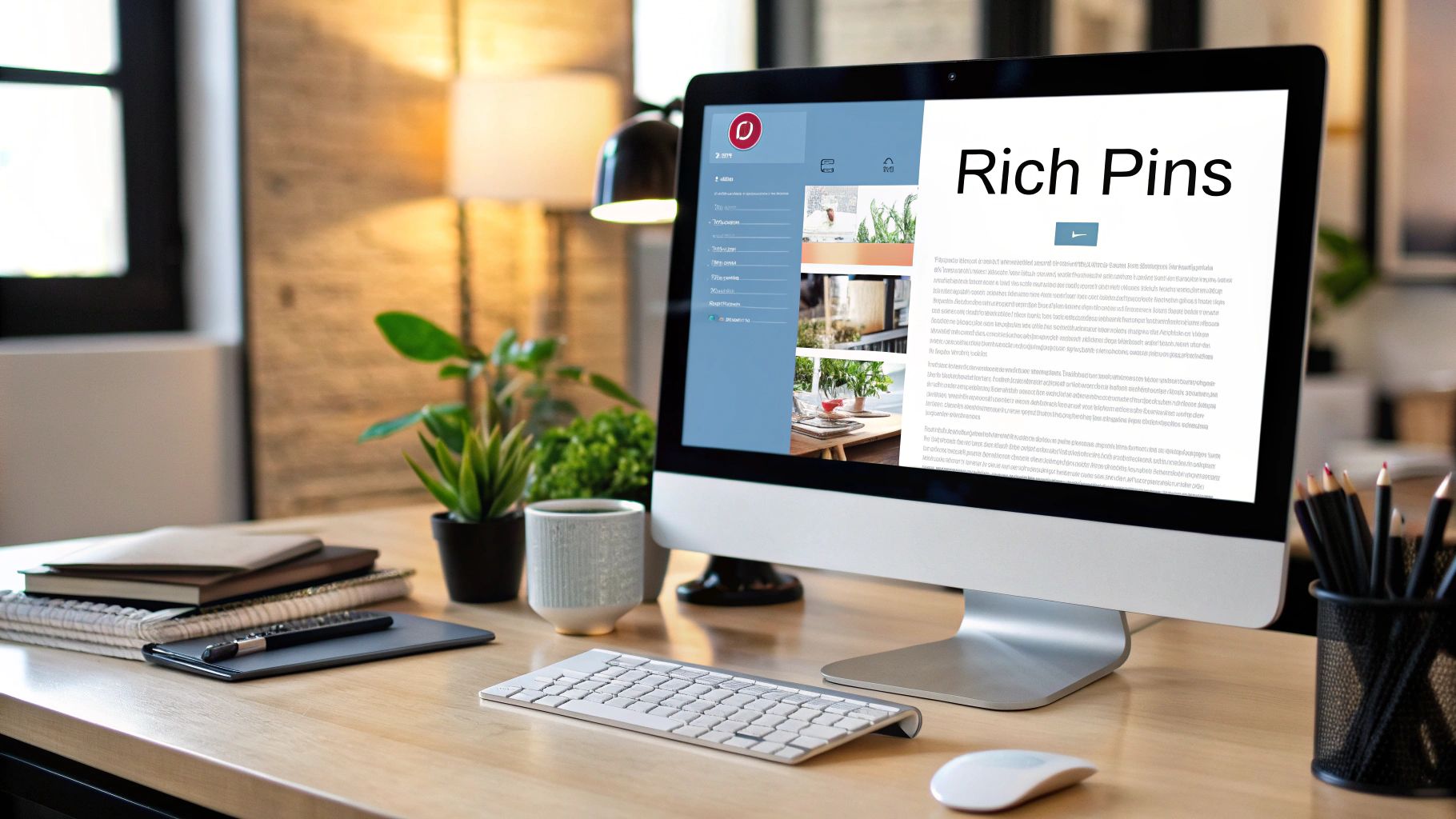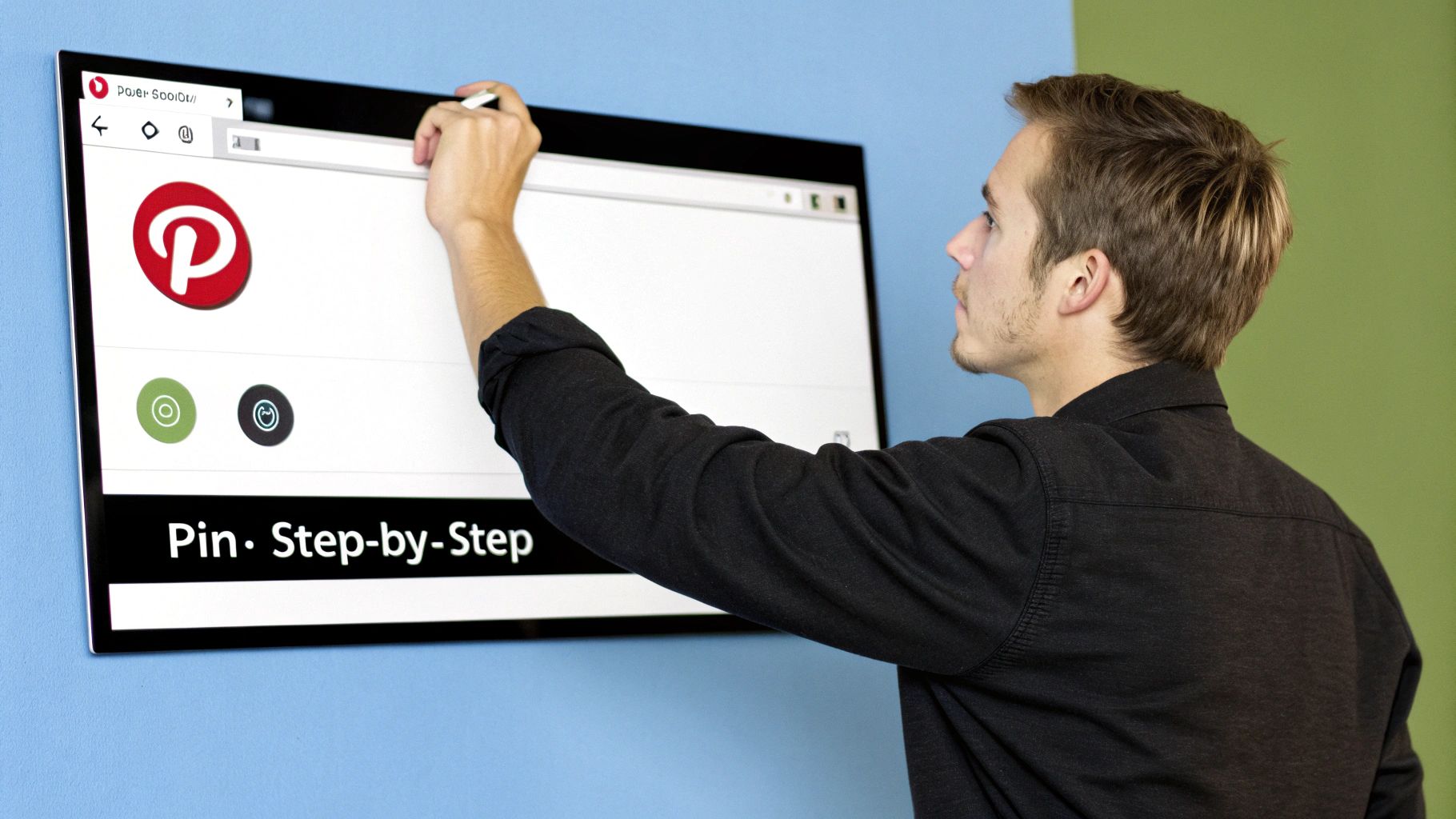How to Pin a Website on Pinterest: Step-by-Step Guide
Knowing how to pin a website on Pinterest is pretty straightforward. Honestly, the easiest methods are either using the Pinterest browser extension for one-click saving or just manually creating a Pin by pasting a URL. Either way, you're turning a webpage into a visual, discoverable bookmark.
Why Pinning Websites Is Such a Smart Traffic Strategy
Before we jump into the "how-to," it’s crucial to understand why this is such a game-changer. Pinning a website isn't just about saving a link for later. It’s a powerful strategy for driving consistent, high-quality traffic to your site over the long haul.
Think about it: on most social platforms, a post has a lifespan of a few hours, maybe a day if you're lucky. On Pinterest, a Pin can keep sending you clicks for months or even years. That's because Pinterest acts more like a visual search engine than a fleeting social feed.
People use Pinterest with a specific goal in mind. They aren't just doomscrolling; they're actively planning their future.
This forward-looking mindset is exactly what makes Pinterest so valuable for businesses and creators. When you pin content from your website, you're placing your brand right in the middle of someone's decision-making process.
The Power of Purchase Intent
The data really drives this home. An incredible 85% of weekly Pinners have actually bought something based on Pins they saw from brands. That's a direct line from discovery to conversion, which is gold for e-commerce and affiliate marketing.
With nearly 500 million monthly active users saving 1.5 billion Pins every single week, the sheer scale of opportunity is massive. Every Pin from your website becomes a potential entry point for a new customer.
For a deeper look at the mechanics, our complete guide on how to pin to Pinterest breaks down all the fundamentals you need to get going.
2 Ways to Pin a Website to Your Pinterest Boards
So, you’ve got a fantastic blog post, a hot new product page, or a landing page you want the world to see. How do you get it onto Pinterest and in front of millions of potential visitors?
Let's walk through the most common ways to pin a website, from the hands-on control of your desktop to the quick-and-easy convenience of your phone. Each method has its place, and knowing which one to use can make all the difference.
Pinning Methods Quick Comparison
To help you decide which approach is right for you in any given situation, here's a quick look at the different ways to pin a website.
Choosing the right method often comes down to balancing speed with control. For your most important content, the desktop method is usually the way to go.
1. The Hands-On Approach: Pinning from Your Desktop
When you want total control over how your content looks and performs, pinning directly from your desktop is the gold standard. I use this method for my most important content because it allows me to fine-tune every detail—from the image to the SEO.
Start by heading to your Pinterest profile. Look for the "Create" button in the navigation menu and select "Create Pin" from the dropdown. This takes you to the Pin editor.
The first thing you’ll do here is drop your website's URL into the destination link field. Paste the full link to your blog post or product page.

Once you've added the link, Pinterest will scan the page and pull in any images it finds. This is a great starting point, but don't just grab the first one you see! Carefully review the options and choose the most eye-catching visual that truly represents your content. A powerful image is what stops the scroll.
Fine-Tuning Your Pin for Maximum Reach
With your image selected, it's time to craft the text that will help people find your Pin. This is where you shift from simply saving a link to actively marketing it.
The Secret Weapon for Power Pinners: The Pinterest Browser Extension

If you're serious about using Pinterest, the official browser extension is an absolute must-have. I honestly consider it a game-changer. This handy little tool, available for Chrome, Firefox, and Edge, adds a "Save" button right into your browser, completely changing how you pin a website URL. It’s faster and way more intuitive.
The real beauty of the extension is its sheer efficiency. Let's say you're scrolling through a design blog and stumble upon the perfect armchair for a client's project. Instead of the old, clunky process—copy the link, open a new tab, go to Pinterest, create a Pin—you can save it directly from the page. This is the go-to method for bloggers, e-commerce shoppers, and anyone who curates content for a living.
Getting the Extension Set Up
Getting started is incredibly simple. Just visit your browser's extension store (like the Chrome Web Store), search for the official "Pinterest Save Button," and add it. After a quick install, you’ll see the familiar Pinterest logo in your toolbar and a "Save" button will appear when you hover over images on most websites.
Click that button, and a window will pop up showing every single pinnable image on that page. This is where the real work gets done, fast.
Mastering Your Pinning Workflow
The extension isn't just about speed; it's about being strategic in the moment. When the grid of images appears, resist the urge to just click the first one you see. Take a second to find the most compelling, vertically-oriented image—those are the ones that consistently perform best on the platform.
Right from that same pop-up window, you can take a few key actions:
Imagine you're on a recipe page for a 30-minute stir-fry. You can instantly pin the most appetizing photo to your "Easy Weeknight Meals" board, changing the description to something personal like, "Can't wait to try this 30-minute chicken stir-fry! Looks perfect for a busy Tuesday." That kind of on-the-fly curation is exactly how you build a valuable and engaging Pinterest profile.
How to Pin a Website from Your Phone

Let's be real—most of our online browsing happens on our phones. With a whopping 82% of Pinterest activity coming from mobile devices, knowing how to pin directly from your phone isn't just a neat trick; it's a core skill.
Inspiration doesn't wait for you to get back to your laptop. It strikes when you're scrolling through an article on your lunch break or find the perfect recipe while waiting in line for coffee. Being able to save those discoveries right then and there is what makes Pinterest so addictive.
There are a couple of ways to get this done on your phone. One is quick and seamless, while the other is a bit more hands-on.
The Faster Method: Use Your Phone's Share Button
By far, the quickest way to pin a website is using your phone's native "Share" function. I use this method all the time because it's incredibly efficient—you can save a Pin in just a few taps without ever leaving the webpage you're on.
Here’s how it works. Say you’re reading a great blog post and want to save it for later.
This little shortcut basically turns your browser into a powerful content-gathering machine, perfect for capturing ideas the second you find them.
The In-App Method
You can also pin a website by doing things the old-fashioned way: copying the URL and creating a Pin from inside the Pinterest app itself. This takes a few more steps but is just as reliable.
First, highlight and copy the full URL from the webpage you want to share.
Next, open up the Pinterest app. Tap the little plus sign (+) at the bottom of your screen and select "Website" from the menu. Paste the URL you copied into the field, and Pinterest will load the page's images. Just like the other method, you can then pick an image, polish your description, and save it to a board.
For those of you who manage brand accounts or pin frequently, you might want to check out our guide on how to schedule Pins on Pinterest to really optimize your workflow.
Creating Pins That Actually Drive Website Traffic

So, you’ve mastered the basic steps of pinning a URL. That's a great start, but let's be honest—just pinning a link is like whispering in a hurricane. If you want to see a real impact on your website traffic, you need to create Pins that make people stop scrolling and actually click.
Think of it this way: you’re not just saving a bookmark for yourself. You're creating a tiny, powerful advertisement designed to pull people from Pinterest directly to your site.
Design and Description Best Practices
Your Pin’s design is the first and most important battle. The Pinterest feed is an incredibly crowded space, so your image has to work hard to get noticed.
Here’s what I’ve learned works best:
Understanding the audience here is key. Pinterest maintains a huge and engaged user base, with women making up a significant 76.7% of users—a powerful demographic if it aligns with your brand. For a closer look at the numbers, check out these Pinterest statistics from Global Tech Stack.
Ultimately, a great Pin is a perfect marriage of eye-catching visuals and persuasive text. If you want a more detailed breakdown of the entire design process, our guide on how to make a Pinterest pin that drives real traffic is the perfect next step.
Common Questions About Pinning from Websites
Even with the best tools, you’ll eventually run into a few snags when pinning from a website. Getting a handle on these common issues will help you troubleshoot on the fly and keep your pinning workflow from grinding to a halt.
A classic problem is getting the dreaded "Sorry, we could not find any images" error. This usually pops up on pages that are light on visuals or use background images in a way that Pinterest’s tools can’t quite grasp. The best workaround? Just create your own custom vertical image, upload it directly when you create a new Pin, and then paste in the website URL as the destination link.
Another point of confusion I see a lot is the difference between a standard Pin and a Rich Pin. Think of a standard Pin as just an image with a link. A Rich Pin, on the other hand, is much smarter. It automatically syncs information from your website, pulling in details like the article headline, product price, or recipe ingredients right onto the Pin itself. To get Rich Pins, you’ll need to add special metadata to your website and then apply for them through Pinterest. It's an extra step, but one that can seriously boost your click-through rates.
How Many Pins Can I Create for One URL?
This is a big one, especially since going overboard can get your account flagged for spammy behavior. Honestly, the answer really depends on your content.
Ready to stop manually pinning and start driving serious traffic? Post Paddle uses AI to turn your website content into hundreds of optimized, ready-to-schedule Pins in minutes. Automate your entire Pinterest strategy and watch your clicks grow. Discover how it works.